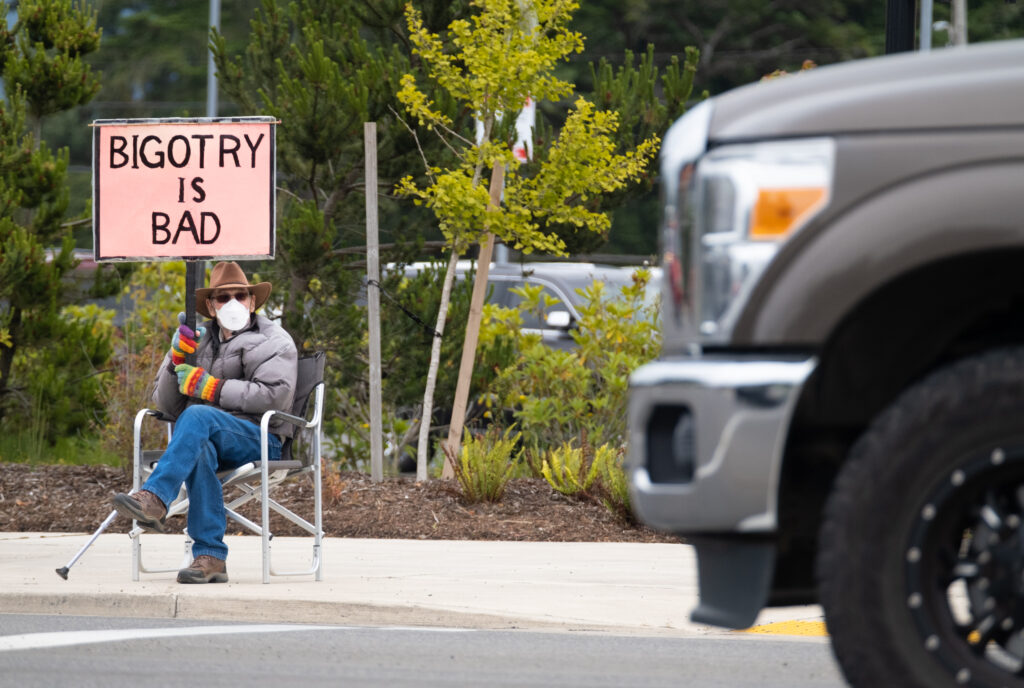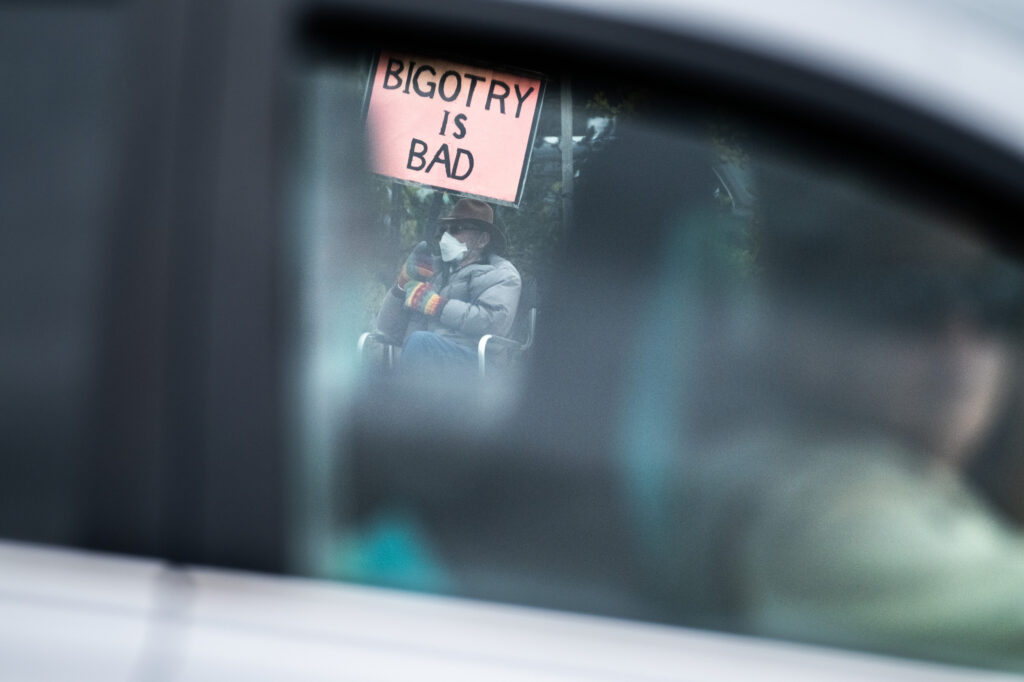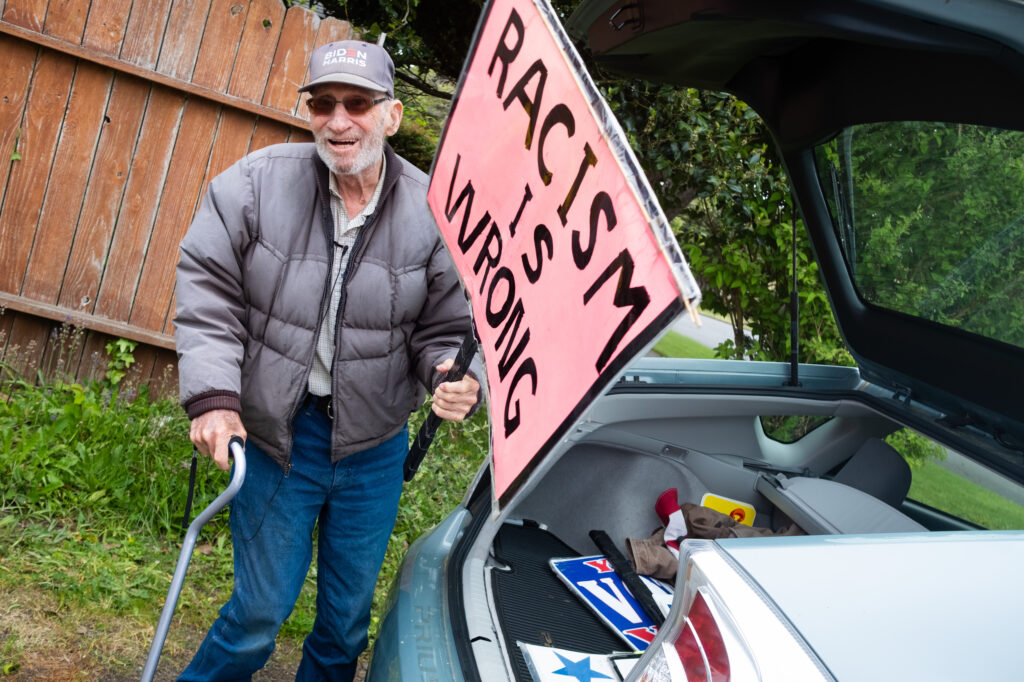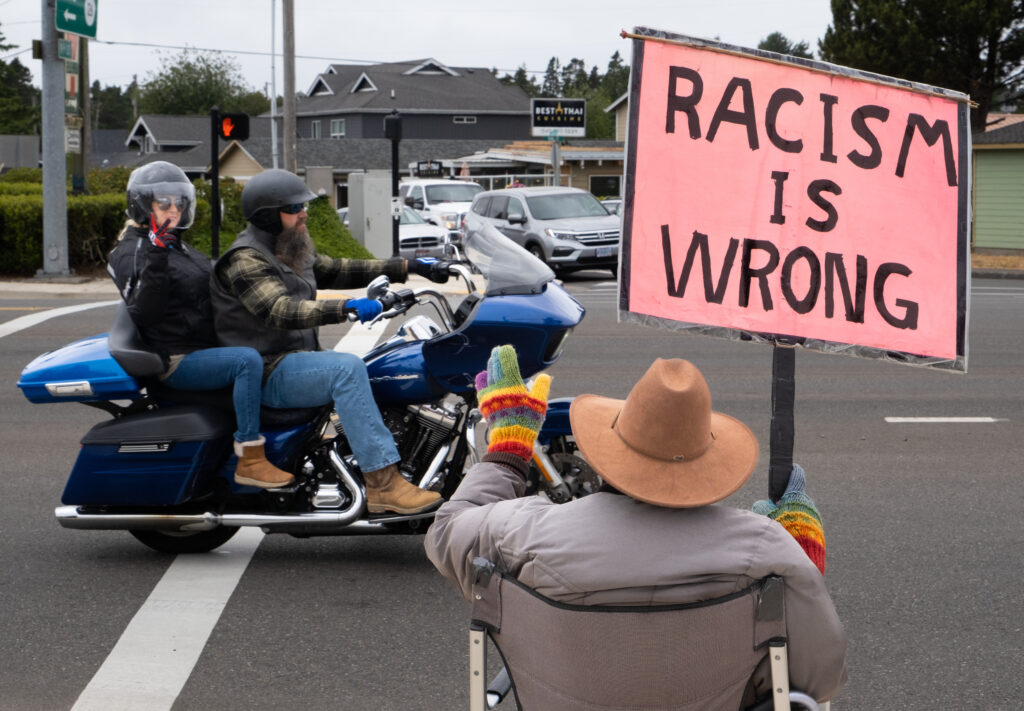by Will Yurman

Befitting his 80 years, Ray Sherrill tells a lot of stories.
They flow like rainwater down a rocky hillside, bouncing off a pebble of a thought into memories unplanned and unpredicted. The story of a summer bus ride to his uncle’s ranch becomes a rumination on American monetary policy before taking a turn to plastics and then bull riding gathering at the bottom of the hill with one thought.
“I lack ambition,” Ray says repeatedly, without prompting. “It’s something missing in my personality. I was behind the door when they passed out ambition.”
Ray sold replacement windows in Kansas, wrote legal briefs for a law firm in California, worked on his Uncle Freckles’s ranch in Oklahoma, taught, landscaped, and worked on an oil rig, twice.
Now the 80-year-old, slowed by emphysema, pauses after a few steps to catch his breath. But he can, and does, sit on the corner of highways 101 and 126 in Florence for an hour, or two, or three, or “once in a great while for four hours,” holding one of his three-word signs including, “Hate is Bad,” and “Racism is Wrong.”

Right From Wrong
Ray Sherrill was born in January of 1943, in Long Beach, California to Mildred Ann Brown and Bertram Sherrill. His father died when Ray was four. His mom raised him and taught kindergarten for 30 years. “An angel. A saint. Everyone who knows her says she’s a saint,” he said.
On a New Year’s Day, when Ray was eight, he sat at the breakfast table reading the Sunday newspaper. A recent graduate from the funny pages to the front page, he read about the laws that would go into effect that first day of the new year. “How do you remember all these?” He asked his mother. “You can’t,” he remembers her replying. “But you know the difference between right and wrong. Do what’s right. Don’t do what’s wrong,” she told him.
“I’m not saying I never did much wrong. But I always knew it was wrong when I was doing it,” he said with a chuckle.
Learned to work hard
As a young boy, Ray spent summers working for his uncle Freckles Brown, a cowboy and rodeo rider, on Brown’s ranch near Lawton, Oklahoma. Warren Granger Brown earned his nickname the old-fashioned way – working long days in the sun. Later in life, the champion bull rider was quoted as saying, ”I don’t have freckles anymore. I reckon those bulls shook ‘em all off,” according to an obituary you can still find on the Rodeo Hall of Fame website.
Ray worked on Brown’s ranch and traveled to rodeos with him, doing whatever his uncle asked. “Ranch work – building fence, feeding cattle. The horses of course.”
Ray said his uncle taught him to work hard. But Ray insists it wasn’t ambition. He simply didn’t want to disappoint Uncle Freckles.
“I don’t work that hard for me,” he said. “I worked really hard to make him look good.”

Ray carried the lesson forward.
He spent 10 years working for a law firm, writing briefs. Where others would write four or five pages, Ray said, his briefs might be forty, fifty or sixty pages long. “As I told my boss once, I saw my job as gathering rocks for him to throw.” And his boss told Ray those briefs won cases, Ray said.
Before and after the law firm, Ray worked as an oil rigger, first as a teenager and then again when he was 40.
It was that second time when Ray broke a promise to himself.
“I swore when I went to work at the oil field, I’d do things that were stupid. I’d do things that were foolish. I just wouldn’t do anything that was stupidly foolish,” Ray said. And mostly he kept that promise.
But someone, Ray never learned who, threw a wrench into his plans. They dropped a 36-inch pipe wrench down the well. “You don’t drop wrenches down the well. That’s a major no-no.” Ray worried that wrench would cost the crew their jobs.
As Ray tells it, he was the skinny one on the rig. He had the crew wrap rags around his ankles and then a chain around the rags and lower him, head first, into the well.
He held a rope as they lowered him down, and he held his breath because of the fumes. One tug of the rope meant stop and two meant pull him up fast. He grabbed the wrench and yanked twice.

“Every once in a while I think about it,” he said. “Oh Christ I was stupid. Incredibly stupid.” He did it, he said, to protect their jobs, for Jerry the rig runner who had never done anything but oil rig work and for all the other men on the crew.
Know the difference between right and wrong, work hard and don’t do anything stupid, unless it’s to help someone else.
At 80, Ray is retired from cowboying, oil rigging, teaching and the rest. What he does do is sit. He sits at the intersection in a folding chair, wearing rainbow mittens to ward off the Florence chill. And he holds his signs. “Hate is Bad.” “Lies are Bad.” “Bigotry is Bad.” “Racism is Wrong.”
His first signs were more complicated. “Alt facts are not facts. They are lies,” on one side, and “Check out the facts for yourself. Educate yourself,” on the reverse. They were Ray’s response to the notion of alternative facts – a phrase coined by then-President Donald Trump spokesperson Kellyanne Conway.
He spent two years as part of the Gorge Ice Resistance in The Dalles, Oregon – residents protesting U.S. Immigration and Customs Enforcement’s detention of immigrants in the local jail. For two years, every day, Ray said, they were out with their signs. And it taught him an important lesson.
“It was a learning experience making these signs. People don’t read paragraphs like that.”
So now the signs are short. The ideas pointed. His ultimate goal is two-word signs – “Hate Hurts.” and “Love Heals.” But he’s 80, and as he says, not an artist. So those will have to wait.

For now, it’s about the hope of starting a conversation, of changing the mind of that one in a hundred, or one in a thousand. And he plans to do it for as long as he can keep breathing.
“Helping people. That’s my reward. That’s my pay. That’s why I’m on the corner. Trying to get people to think for a moment. Maybe even have a conversation about it. But think about it. Everything. The universe, the nature of the universe.
As Ray says, he has no ambition.

Thanks for sharing Rays story. I’m a honked and waver.
Great to hear his story.
Ray is also a climate champion. He has joined us in front of the Florence City hall with his “Save the Earth” sign during our Friday climate strikes for the last four years.
I first met Ray during the weekly Climate Strike in front of Florence City Hall on a Friday afternoon. He was sitting in a folding chair holding one of his wordier signs. It read:
EPA
CLEAN
FOOD
AIR
WATER
After Mike and Pat Allen introduced us, we chatted and learned a little about each other. This was no easy feat, with the noise of the traffic flowing a few feet away from the sidewalk where he sat, and we stood. A few weeks later, I noticed Ray sitting on the corner of 101 and 126, holding what has become my favorite sign of his “Hate is Bad.” I admire Ray’s commitment to delivering simple but important messages in good and bad weather. He is a hero!
P.S. Pat and Mike Allen are amazing, too! They have been conducting a weekly climate strike in front of City Hall for almost four years. Their commitment to a beautiful and resilient Florence community now and in the future is something we can all aspire to.